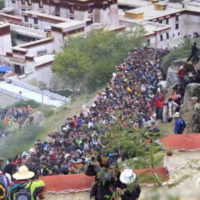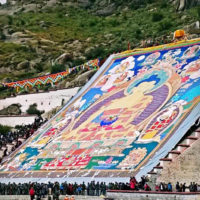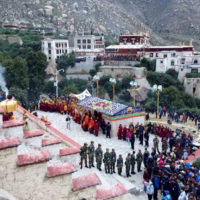
These images circulating on social media show the presence of troops among pilgrims and tourists gathering to see the thangka at Drepung for the Shoton Festival in Lhasa, a religious ceremony now appropriated by the authorities.
- A new Communist Party chief has taken over in the Tibet Autonomous Region (TAR), using his first statement to underline the importance of the political ‘struggle’ against the Dalai Lama. Chinese official Wu Yingjie has spent almost his entire career in Tibet, unlike most of his predecessors, and is known for his involvement advancing hardline Party campaigns and crackdowns.
- The appointment of the top Party boss in the region – a post that has never been held by a Tibetan – was announced following three high-level visits by Party leaders, including Yu Zhengsheng to the TAR in mid-August. The announcement, part of a reshuffle including the transfer of the outgoing TAR Party chief Chen Quanguo to Xinjiang, followed the highly secretive annual gathering of Party leaders at the seaside resort of Beidaihe in Hebei this summer.
- Images have emerged of an intense military presence in Lhasa this week at the time of a religious festival controlled by the Chinese authorities.
Appointment indicates continuity, linked to crackdowns
In his first statement as Party Secretary, Wu Yingjie – a former propaganda official – emphasized the key importance of a deepened ‘struggle’ against the Dalai Lama, using retrograde political language stating that the authorities must “expand positive propaganda, thoroughly expose and criticize the Dalai”.[1] The tone of the speech and Wu’s appointment indicates a continuity of tough policies in the region.[2]
As Commander of the ‘Stability Maintenance Corps’, Wu Yingjie has been particularly associated with the harsh and violent crackdown in Nagchu (Chinese: Naqu) prefecture in the TAR particularly following the refusal of villagers in Driru (Chinese: Biru) to display Chinese national flags in October 2014. This sweeping crackdown has involved an incident in which police fired into unarmed crowds, Tibetans have died under torture, including a senior monk who was beaten to death,[3] and the arrest and imprisonment of hundreds of Tibetans.[4] News emerged last month of the death of a Tibetan man, Trigyal, who died following torture while serving a 13-year prison sentence for refusing to fly a Chinese flag.[5]
Prior to the announcement of his appointment, Wu Yingjie visited a monastery in Driru in early August, underlining that the deepening oppression in Nagchu and elsewhere in the TAR is imposed as part of a more systematic, quasi-legalistic approach that aims to strengthen Communist Party control over Tibetan Buddhist practice and weaken religious institutions still further, as well as escalating the crackdown in lay society.
During his visit on August 4-5 (2016), Wu Yingjie declared that monasteries must ‘unswervingly’ stand with the Chinese Communist Party in “struggling against the Dalai clique”, and that monks and nuns must follow the guidance of Xi Jinping in order to carry out their religious work. Wu warned that it was imperative for monks and nuns to become ‘politically reliable’.[6] The CCP, which promotes atheism, requires monks and nuns to respect the Party above all other priorities. A harsh ‘rectification’ drive that was launched in Driru in 2014 as part of the crackdown stated that monasteries deemed ‘illegal’ will be torn down and Tibetans who possess images of the Dalai Lama or place traditional prayer (mani) stones will be severely punished.[7]
Wu also met with Party cadres based in villages in Driru,[8] underlining the emphasis on more intrusive and rigorous strategies that have been in place in the TAR in the aftermath of the protests in Lhasa in March, 2008.[9]
The ‘Stability Maintenance Corps’, headed by Wu Yingjie in Lhasa, is based on Xi Jinping’s focus on ‘long-term stability’ – political language for the eradication of dissent and enforcement of compliance to Party policies.[10] Combined with his long-term career in the region, Wu’s position heading ‘stability’ operations is likely to give him a strong power base with the military in the TAR.
Wu Yingjie, who was born in Shangdong, began his career at the Central Party School in Beijing, and unusually for a TAR Party Secretary, has spent virtually his entire career in Tibet, beginning in the closing years of the Cultural Revolution on a farm in Nyingtri (Chinese: Linzhi). He even went so far as to describe himself as a “local Tibetan”, saying that he was “brought up by the Party, the people, the Tibetan Plateau and all the ethnic groups of Tibet” and that he loves “the land and the hardworking people here.”[11]
This is in stark contrast to his predecessors, notably former President and Party Secretary Hu Jintao, who began his career in Tibet in the same role and who spent as much time away from the plateau as possible, telling a Western journalist that he disliked Tibet’s “altitude, climate and lack of culture” and distrusted Tibetans.[12] Before being posted to the TAR, former Party Secretary Chen Quanguo, who is from Henan, was the Governor of Hebei Province and had no involvement in any ‘ethnic minority’ issues before his term in Tibet. Under the same reshuffle announced following the Beidaihe meeting of the Politburo, Chen Quanguo has now been transferred to Xinjiang Uyghur Autonomous Region (East Turkestan), replacing Zhang Chunxian as Party Secretary, according to Xinhua. (August 29, 2016).[13]
High-level Party delegations precede appointment
Three high-level Party delegations visited the Tibet Autonomous Region in mid-August. On August 14, member of the Politburo Yu Zhengsheng visited the politically sensitive area of Chamdo (Chinese: Changdo) in the TAR, following meetings with Chen and other TAR leaders in the TAR from 12-13 August (2016).[14] Last year, a 65-member delegation from Beijing led by top Chinese political advisor Yu presided over a ceremony on September 8 (2015) in front of the Potala Palace, the Dalai Lama’s traditional winter residence, to mark the 50th anniversary of the Chinese Communist Party’s establishment of the Tibet Autonomous Region.
The crackdown in the TAR has been particularly intense in Chamdo prefecture as well as in Nagchu. The Chinese government regards Chamdo as “a strategic bridge between the Tibet Autonomous Region and the neighboring provinces of Sichuan, Yunnan and Qinghai.” (Tibet Daily, April 17, 2009).[15] The region has been of particular strategic importance to Beijing since the Communist authorities gained control of central Tibet when Chamdo, eastern Tibet’s provincial capital, fell to the People’s Liberation Army on October 7, 1950.
Also on August 14, the political commissar of the Chinese People’s Armed Police forces met Chen Quangguo and other leaders,[16] a day after the visit of Zhu Shengling, a senior military figure, on August 13.[17] The Chinese state media reported that Zhu, the Political Commissar of the National Defense Department of the Central Military Commission, met Deputy Party Secretary Deng Xiaogang, who has been prominent in ‘stability maintenance’ across the TAR.
Strong military presence at religious festival appropriated by the authorities
Images circulating on social media showed troops amidst pilgrims and tourists gathering in Lhasa for the unveiling of a thangka (religious painting) as part of the Shoton (Yogurt) festival beginning on September 1 (2016).
Although the festival was traditionally a religious one, it has for many years been appropriated by the authorities in particular the State Council, and was announced in an official press conference on August 19.[18] It has been used by the TAR authorities to promote trade and tourism as well as to underline the political message of Tibetan Buddhism being controlled and ‘managed’ by the CCP authorities, a message that Wu Yingjie has strongly asserted during his tenure.
- These images circulating on social media show the presence of troops among pilgrims and tourists gathering to see the thangka at Drepung for the Shoton Festival in Lhasa, a religious ceremony now appropriated by the authorities.
- These images circulating on social media show the presence of troops among pilgrims and tourists gathering to see the thangka at Drepung for the Shoton Festival in Lhasa, a religious ceremony now appropriated by the authorities.
- These images circulating on social media show the presence of troops among pilgrims and tourists gathering to see the thangka at Drepung for the Shoton Festival in Lhasa, a religious ceremony now appropriated by the authorities.
- These images circulating on social media show the presence of troops among pilgrims and tourists gathering to see the thangka at Drepung for the Shoton Festival in Lhasa, a religious ceremony now appropriated by the authorities.
- These images circulating on social media show the presence of troops among pilgrims and tourists gathering to see the thangka at Drepung for the Shoton Festival in Lhasa, a religious ceremony now appropriated by the authorities.
- These images circulating on social media show the presence of troops among pilgrims and tourists gathering to see the thangka at Drepung for the Shoton Festival in Lhasa, a religious ceremony now appropriated by the authorities.
- These images circulating on social media show the presence of troops among pilgrims and tourists gathering to see the thangka at Drepung for the Shoton Festival in Lhasa, a religious ceremony now appropriated by the authorities.
Footnotes:
[1] Translation of the relevant section of his speech to the Tibet Autonomous Region Party Committee on August 31 (2016) into English by ICT is as follows: “Eighth is to firmly and unswervingly grasp ideological work. We must further implement Secretary Xi Jinping’s important instructions on “propaganda and ideological work is for strengthening Marxism’s leading position in the ideological field, consolidating the entire Party and the people of the entire country’s ideological foundation for a united struggle,” adhering to holding the banner aloft, overseeing the entire situation, serving the people, reforming and innovating, strengthening research into ideological work in Tibet, deepen education on core interests, expand positive propaganda, thoroughly expose and criticize the Dalai, vigorously implement cultural projects that benefit the people, strengthen propaganda concerning Tibet outside the country, and strive to create a new propaganda and ideological work situation.” Tibet Daily, Chinese state media report in Chinese, September 1, 2016 http://cpc.people.com.cn/n1/2016/0901/c117005-28683922.html In the third paragraph, Wu Yingjie also makes reference to the need to “deeply carry out the struggle against the Dalai clique”.
[2] His appointment was announced by the state media in English on August 28 (2016): http://news.xinhuanet.com/english/2016-08/28/c_135640050.htm
[3] Ngawang Jampel, 45, (also known as Ngawang Jamyang), was among three monks from Tarmoe monastery in Driru (Chinese: Biru), who ‘disappeared’ into detention on November 23, 2013 while on a visit to Lhasa. This followed a police raid on the monastery, which was then shut down, and paramilitary troops stationed there. Less than a month later, Ngawang Jampel, who had been healthy and robust, was dead, and Tibetan sources in contact with Tibetans in Driru said it was clear he had been beaten to death in custody. Ngawang Jampel had been one of the highest-ranking scholars at his monastery and had founded a Buddhist dialectics class for local people. He gave free teachings on Tibetan Buddhism and culture to lay people and monks, and was known for his skills in mediation in community disputes. See ICT report, ‘Torture and Impunity: 29 cases of Tibetan political prisoners’, https://www.https://savetibet.org/newsroom/torture-and-impunity-29-cases-of-tibetan-political-prisoners/
[4] See the extensive reporting by the Tibetan Center for Human Rights and Democracy on the crackdown in Driru at www.tchrd.org
[5] RFA report, August 2, 2016, http://www.rfa.org/english/news/tibet/tibetan-man-who-refused-to-fly-chinese-flag-dies-02082016154201.html
[6] Chinese state media report in Chinese, extracts above translated into English by ICT: http://epaper.chinatibetnews.com/xzrb/html/2016-08/08/content_713905.htm
[7] Translation and analysis, ICT report, November 20, 2014, https://www.https://savetibet.org/harsh-new-rectification-drive-in-driru-nuns-expelled-and-warning-of-destruction-of-monasteries-and-mani-walls/
[8] Chinese state media report, http://epaper.chinatibetnews.com/xzrb/html/2016-08/07/content_713637.htm
[9] ICT has documented how these measures have been extended to the eastern Tibetan areas of Kham and Amdo, outside the TAR: https://www.https://savetibet.org/tightening-of-an-invisible-net-new-security-measures-in-eastern-tibet-heighten-surveillance-control/
[10] See Human Rights Watch report, ‘Relentless: Detention and Prosecution of Tibetans under China’s Stability Maintenance Campaign”, May 22, 2016 https://www.hrw.org/report/2016/05/22/relentless/detention-and-prosecution-tibetans-under-chinas-stability-maintenance
[11] China Daily, August 30, 2016, http://africa.chinadaily.com.cn/china/2016-08/30/content_26638056.htm
[12] Jonathan Mirsky wrote: “It was soon after Hu’s arrival in Lhasa that I met him there. I was then the China correspondent of The Observer, a London Sunday newspaper. I asked him how he was enjoying his new job. He told me how much he disliked Tibet’s altitude, climate and lack of culture. His family was in Beijing, he said, a safe and healthy place in comparison. When I suggested that he must have made some Tibetan friends, he replied that if there were ever a disturbance in Lhasa he feared no Tibetan would protect him.” ‘HU JINTAO AND THE TIBETAN ISSUE’, China Brief, Volume: 2 Issue: 10, May 9, 2002, http://www.jamestown.org/programs/chinabrief/single/?tx_ttnews%5Btt_news%5D=28530&tx_ttnews%5BbackPid%5D=192&no_cache=1#.V8lacT4rL-Y
[13] http://news.xinhuanet.com/english/2016-08/29/c_135642583.htm
[14] Xinhua, August 14, 2016, http://news.xinhuanet.com/2016-08/14/c_1119388339.htm
[15] ICT report, https://www.https://savetibet.org/determination-to-resist-repression-continues-in-combat-ready-chamdo-frontline-of-patriotic-education/
[16] State media report in Chinese, http://gf.vtibet.cn/gfdt/201608/t20160815_419483.html
[17] Chinese state media report, http://epaper.chinatibetnews.com/xzrb/html/2016-08/14/content_715400.htm
[18] State media report in Chinese, http://www.scio.gov.cn/xwfbh/gssxwfbh/xwfbh/xizang/Document/1488095/1488095.htm








